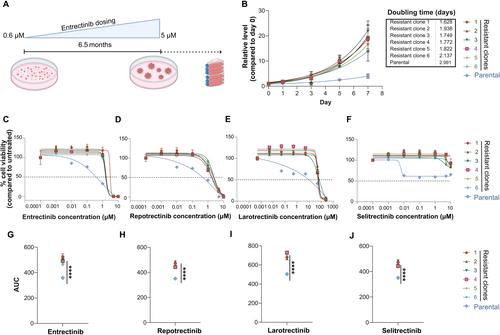下载PDF
{"title":"在体外LMNA::NTRK1重排软组织肉瘤细胞模型中,获得性NF2突变使细胞对TRK抑制剂产生抗药性","authors":"Yanjiang Chen, Sabrina Steiner, Catherine Hagedorn, Sarah Kollar, Alicia Pliego-Mendieta, Martina Haberecker, Jan Plock, Christian Britschgi, Lara Planas-Paz, Chantal Pauli","doi":"10.1002/path.6282","DOIUrl":null,"url":null,"abstract":"<p>Genomic rearrangements of the neurotrophic receptor tyrosine kinase genes (<i>NTRK1, NTRK2</i>, and <i>NTRK3</i>) are the most common mechanism of oncogenic activation for this family of receptors, resulting in sustained cancer cell proliferation. Several targeted therapies have been approved for tumours harbouring <i>NTRK</i> fusions and a new generation of TRK inhibitors has already been developed due to acquired resistance. We established a patient-derived <i>LMNA</i>::<i>NTRK1</i>-rearranged soft-tissue sarcoma cell model <i>ex vivo</i> with an acquired resistance to targeted TRK inhibition. Molecular profiling of the resistant clones revealed an acquired <i>NF2</i> loss of function mutation that was absent in the parental cell model. Parental cells showed continuous sensitivity to TRK-targeted treatment, whereas the resistant clones were insensitive. Furthermore, resistant clones showed upregulation of the MAPK and mTOR/AKT pathways in the gene expression based on RNA sequencing data and increased sensitivity to MEK and mTOR inhibitor therapy. Drug synergy was seen using trametinib and rapamycin in combination with entrectinib. Medium-throughput drug screening further identified small compounds as potential drug candidates to overcome resistance as monotherapy or in combination with entrectinib. In summary, we developed a comprehensive model of drug resistance in an <i>LMNA</i>::<i>NTRK1</i>-rearranged soft-tissue sarcoma and have broadened the understanding of acquired drug resistance to targeted TRK therapy. Furthermore, we identified drug combinations and small compounds to overcome acquired drug resistance and potentially guide patient care in a functional precision oncology setting. © 2024 The Authors. <i>The Journal of Pathology</i> published by John Wiley & Sons Ltd on behalf of The Pathological Society of Great Britain and Ireland.</p>","PeriodicalId":232,"journal":{"name":"The Journal of Pathology","volume":"263 2","pages":"257-269"},"PeriodicalIF":5.6000,"publicationDate":"2024-04-12","publicationTypes":"Journal Article","fieldsOfStudy":null,"isOpenAccess":false,"openAccessPdf":"https://onlinelibrary.wiley.com/doi/epdf/10.1002/path.6282","citationCount":"0","resultStr":"{\"title\":\"Acquired NF2 mutation confers resistance to TRK inhibition in an ex vivo LMNA::NTRK1-rearranged soft-tissue sarcoma cell model\",\"authors\":\"Yanjiang Chen, Sabrina Steiner, Catherine Hagedorn, Sarah Kollar, Alicia Pliego-Mendieta, Martina Haberecker, Jan Plock, Christian Britschgi, Lara Planas-Paz, Chantal Pauli\",\"doi\":\"10.1002/path.6282\",\"DOIUrl\":null,\"url\":null,\"abstract\":\"<p>Genomic rearrangements of the neurotrophic receptor tyrosine kinase genes (<i>NTRK1, NTRK2</i>, and <i>NTRK3</i>) are the most common mechanism of oncogenic activation for this family of receptors, resulting in sustained cancer cell proliferation. Several targeted therapies have been approved for tumours harbouring <i>NTRK</i> fusions and a new generation of TRK inhibitors has already been developed due to acquired resistance. We established a patient-derived <i>LMNA</i>::<i>NTRK1</i>-rearranged soft-tissue sarcoma cell model <i>ex vivo</i> with an acquired resistance to targeted TRK inhibition. Molecular profiling of the resistant clones revealed an acquired <i>NF2</i> loss of function mutation that was absent in the parental cell model. Parental cells showed continuous sensitivity to TRK-targeted treatment, whereas the resistant clones were insensitive. Furthermore, resistant clones showed upregulation of the MAPK and mTOR/AKT pathways in the gene expression based on RNA sequencing data and increased sensitivity to MEK and mTOR inhibitor therapy. Drug synergy was seen using trametinib and rapamycin in combination with entrectinib. Medium-throughput drug screening further identified small compounds as potential drug candidates to overcome resistance as monotherapy or in combination with entrectinib. In summary, we developed a comprehensive model of drug resistance in an <i>LMNA</i>::<i>NTRK1</i>-rearranged soft-tissue sarcoma and have broadened the understanding of acquired drug resistance to targeted TRK therapy. Furthermore, we identified drug combinations and small compounds to overcome acquired drug resistance and potentially guide patient care in a functional precision oncology setting. © 2024 The Authors. <i>The Journal of Pathology</i> published by John Wiley & Sons Ltd on behalf of The Pathological Society of Great Britain and Ireland.</p>\",\"PeriodicalId\":232,\"journal\":{\"name\":\"The Journal of Pathology\",\"volume\":\"263 2\",\"pages\":\"257-269\"},\"PeriodicalIF\":5.6000,\"publicationDate\":\"2024-04-12\",\"publicationTypes\":\"Journal Article\",\"fieldsOfStudy\":null,\"isOpenAccess\":false,\"openAccessPdf\":\"https://onlinelibrary.wiley.com/doi/epdf/10.1002/path.6282\",\"citationCount\":\"0\",\"resultStr\":null,\"platform\":\"Semanticscholar\",\"paperid\":null,\"PeriodicalName\":\"The Journal of Pathology\",\"FirstCategoryId\":\"3\",\"ListUrlMain\":\"https://onlinelibrary.wiley.com/doi/10.1002/path.6282\",\"RegionNum\":2,\"RegionCategory\":\"医学\",\"ArticlePicture\":[],\"TitleCN\":null,\"AbstractTextCN\":null,\"PMCID\":null,\"EPubDate\":\"\",\"PubModel\":\"\",\"JCR\":\"Q1\",\"JCRName\":\"ONCOLOGY\",\"Score\":null,\"Total\":0}","platform":"Semanticscholar","paperid":null,"PeriodicalName":"The Journal of Pathology","FirstCategoryId":"3","ListUrlMain":"https://onlinelibrary.wiley.com/doi/10.1002/path.6282","RegionNum":2,"RegionCategory":"医学","ArticlePicture":[],"TitleCN":null,"AbstractTextCN":null,"PMCID":null,"EPubDate":"","PubModel":"","JCR":"Q1","JCRName":"ONCOLOGY","Score":null,"Total":0}
引用次数: 0
引用
批量引用



